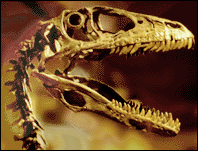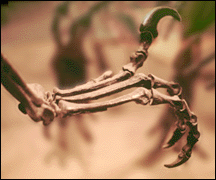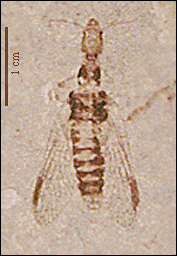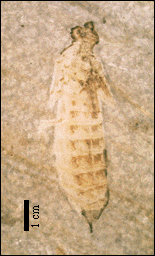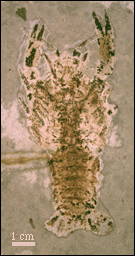Go back to Lecture 19
BACK TO DINOSAURS 2001 HOME PAGE
Lecture 20 - The Early Cretaceous - Europe, the Cloverly Formation, Montana, Mongolia and North China
The Cretaceous
|
The name Terrain Cretacé was first applied to strata in France that consisted largely of the white soft limestone termed chalk (craie in french) and assoicated units by dºOmalius dºHalloy in 1822. DºHalloy was in the employ of Baron de Monbret, in charge of statistical information in France at the time. The Terrain Cretacé was easily recognized across the English Channel and English geologists quickly began calling the units the Cretaceous System, and similar strata were quickly deliniated over much of Europe. Cretaceous rocks, especially the chalk, make strikingly beautiful cliffs. The famous cliffs around Etretat on the Brittany coast, painted many times by Monet, are chalk cliffs as are the White Cliffs of Dover. |
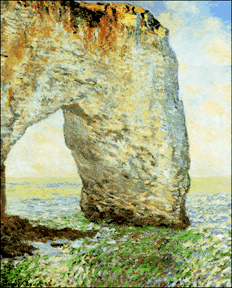
Claude Monetºs cliffs at Etretat
|
Early Cretaceous - Wealden of Europe, Cloverly Formation of Montana, and Africa and South America
Early Cretaceous World
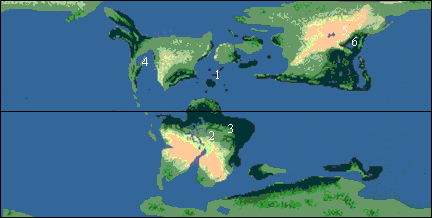
The Early Cretaceous was a time of relatively high sea level. Continental drift had accelerated from the Late Later Jurassic and the hotter and consequently less dense spreading ridges were eleveated and dispaced ocean waters onto the low lying areas of the continemnts. High sea level and dispersed continemnts resulted in a relatively more humid world. Broad coastal plains preserved much largely continetal deposits in Europe and North America, while rifting preserved many continental sequences in South America, Africa, and China. In this map locations are as follows: 1, Wealden of England and Belgium; 2, Early Cretaceous of Niger; 3, Late Cretaceous of Egypt; 4, Cloverly Formation of Montana; 5, Early Cretaceous of Mongolia; and 6; Early Cretaceous lacustrine deposits of Lioning Province, China.
Wealden of England and Europe
The Wealden is a large continental deposit spread over much of southern England and western Europe. These were the deposits that produced the original material described by Mantel in England of Iguanodon. Another ornithischian dinosaur to come out of the English Wealden is Hypsilophodon foxii.
Hypsilophodon
| Hypsilophodon is a small ornithopod, one of the most primitive of the group, characterized by the shared derive character of having the jaw joint well below the level of the tooth row. Like Lesothosaurus and Heterodontosaurus, it was probabaly a fairly fast little dinosaur.
|
 |
The illustration above is based on the monograph by Galton, 1974).
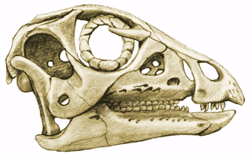 |
The skull of Hypsilophodon is similar to that of Heterodontosaurus, except that canines are lacking and the skull is more massive. There are, of course, many differences in detail. This drawing is based on Galton (1974) and Brett-Surman (1997).
|
|
The teeth of Hypsilophodontids supposedly have a stronger ridge running down the length of the tooth than other ornithopods, although I find this character unconvincing. This is a worn dentary tooth from the right side (based on Galton, 1974). |
 |
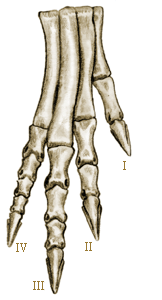
|

Above, the right manus of Hypsilophodon
differs from that of more primitive
ornithischians by having a divergent digit V,
probably with more phalanges than shown here.
It is appears more primitive than other
ornithopods in having a rather
normal looking digit I.
On left, right pes of Hypsilophodon
(same scale as manus). A rudimentary digit V
lies hidden behind the metatarsals.
|
Iguanodon
Mantelºs description of Iguanodon was massively supplimented by the discovery of articulated skeletons of Iguanodon in a coal mine in 1878 in Bernissart, Belgium at a depth of 1056 ft.
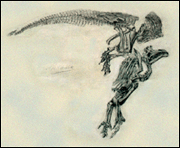 |
On the left is a drawing of an Iguanodon skeleton as it appeared after excavation. The large dislocations in the skeleton were caused by faults of tectonic origin. (drawing by Lavalette).
|
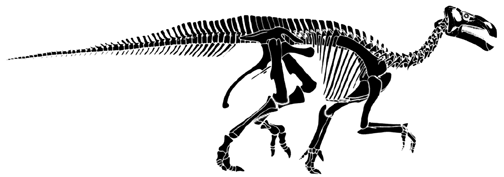
Modern reconstruction of Iguanodon (based on Brett-Surman, 1997) in quadrupedal walking pose. Bipedal locomotion was certainly also possible.
A fairly large theropod (9.5 m) was found in the Wealden of England in 1988. This theropod, Baryonyx walkeri has skull similar but more elongate than Dilophosaurus. It has a small crest in midline, but not a large double crest. It seems to be a ceratosaur. It has a very large claw on digit I of the manus, which make most sense as a defensive weapon. Its long snout and the fact that remains of fish were found in its gut suggest that it was a fish-eater.

Reconstruction of Baryonyx walkeri based on Paul (1988).
Dinosaurs evidently very closely related to Baryonyx are known from the Early and Late Cretaceous of Africa and the Early Cretaceous of Brazil. One of these is Spinosaurus aegyptiacus from the early Late Cretaceous of Egypt, which is a spectacular although fragmentary form, with a large "sail" made up of neural spines. Spinosaurus. Its skull, as can be judged from fragments, was evidently very similar to that of Baryonyx. The total length of this peculiar ceratosaur was probably about 15 m. The "sail" alone was over 1.6 m high. It is interesting and probably significan that these sail-back theropods come from deposits formed close to the Cretaceous Equator.
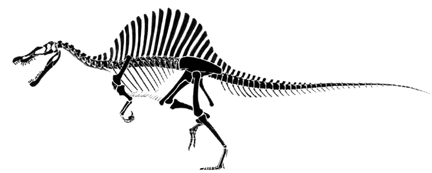 Reconstruction of Spinosaurus aegyptiacus based on Baryonyx from Paul (1988).
Vertebra on right based on Stromer (1915). |
Single dorsal (back) vertebra with very long neural spine of Spinosaurus.
 |
As in the case of the Permian Dimetrodon and Edaphosaurus, the sail in Spinosaurus almost certainly had a theromoregulatory function, probably to loose heat. There are also sail back iguanodontids. The best known is Ouranosaurus from the Early Cretaceous of Niger. Like Spinosaurus, Ouranosaurus has a sail supported by very high neural spines.

Reconstruction of Ouranosaurus based on Brett-Surnam (1997).
Cloverly Formation
|
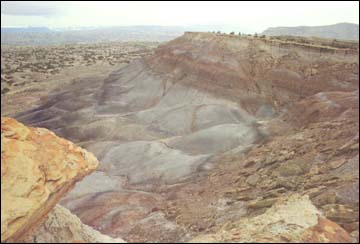
|
The Cloverly formation outcrops in Wyoming and Montana and consists of variegated mudstones and sandstones deposited by streams and rivers and in shallow lakes. A reasonably rich assemblage of dinosaurs has been produced from the Cloverly, notably Deinonychus, Tenontosaurus, and Sauropelta (all below). |
Deinonychus
Maniraptora
Deinonychosauria
Deinonychus antirrhopus -Cloverly
Sauropelta
A number of ornithischians have been found along with Deinonychus including an ankylosaur and iguanodontian ornithopod.
Sauropelta is a medium sized ankylosaur. The Ankylosauria are members of the Tyreophora and the sister group of the Stegosauria. Their most critical shared derived character is that they are covered by an armor made up of small plates. They are split into two families, the Nodosauridae, of which Sauropelta is a member, and the Ankylosauridae. The Nodosauridae have the shared derived character of a well-develped secondary palate, while Ankylosauridae have a wide head and a tail club.

Sauropelta, with armor shown in yellow overlay. Based on Carpenter (1997).
Tenontosaurus

Mongolia
The Late Cretaceous of Mongolia will be the subject of the entire next lecture. Here we need to bring up only one critical group from the Early Cretaceous.
This is the ornithischian, cerapodan group, the Psittacosauridae, or parrot-beaked dinosaurs. The Psittacosauridae are the most primitive members of the Ceratopsia, within the Marginocephalia.
Psittacosaurids are known only from Early Cretaceous age rocks of Asia. They are known from over 75 individuals including more than 15 skeletons.
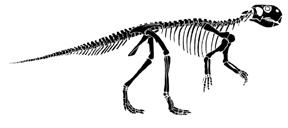 |
The skeletal reconstruction of Psittacosaurus mongoliensis is based on material from the Early Creataceous Oshih Formation, Red Mesa, Oshih basin, Peoples Repubic of Mongolia (redrawn from Forster and Sereno, 1997). |
| The postcranial skeleton, for the most part, differs little from that of Lesothosaurus, except that is is more massive (but also larger - 2 m). However the manus are peculiar, with proportions suggestive of Heterodontosaurus. These odd hands are hypothesized to be a shared derive character uniting psittacosaurs, and that view is adopted here. I belive it actually indicates problems with the basic relationships of the basal ornithischians.
Skull of Psittacosaurus mongoliensis, right, (based on Sereno, 1986; Forster and Sereno, 1997). The shared derived character for the Marginocephalia is visible here with an expansion in the rear of the skull, forming only a tiny hint of a frill. However, a fully developed rostral bone (r) is present, and that is the shared derive character of the Ceratopsia. The rostral bone is a new bone, not paired, which is added on in front of the premaxillae, and opposes the predentary bone (pd), itself a character of the Ornithischia in general.
|
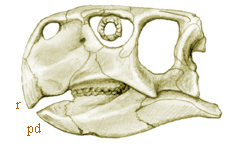 |
Now we are in a position to discuss the cladistic relationships of nearly all the groups of ornithischians. The only two groups we have not looked at are the Neoceratopsia and the Hadrosauria, which will be examined in the next lecture.
On the left are the shared derived characters of the group shown on the cladogram on the right.
1. cheeks
2. armor
3. armor as plates covering back
4. armor as spikes or plates in a few rows
5. uneven enamel
6. back part of skull makes shelf
7. rostral bone
8. frill
9. peculiar hands
10. domed head
11. jaw joint below tooth row
12. elongate hands
13. prepubic process well developed
14. ridge on teeth
15. reduction in manus digits I and V (and large nares)
16. manus digit 1 spike-like |
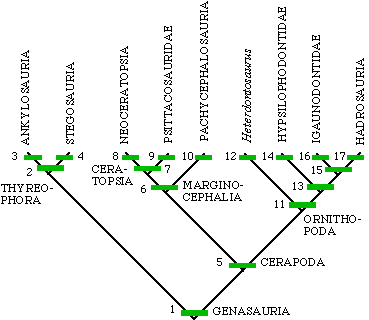 |
Northern Liaoning Province
http://www.sinonews.com/china/liaoning.htm
Jehol Group
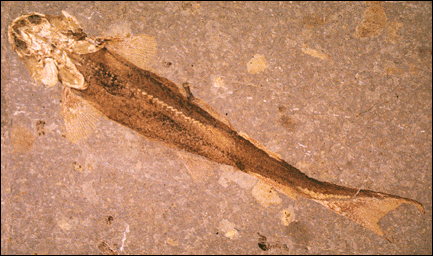
Saurischia
Theropoda
Tetanurae
Arctometatarsalia
Troodontia
Sinornithoides youngi - Mongolia
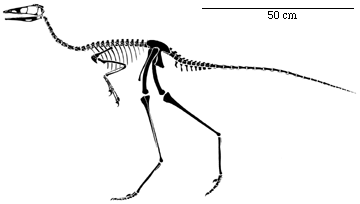
1. three-toed foot
2. digits IV and V lost on hand
3. long arms
4. semilunate carpal
5. fused pelvis
6. large hole in lacrimal bone in skull
7. ?no unique derived characters?
8. giant, hook-like claw on digit II of pes
9. flight feathers
10. ?no unique derived characters?
11. proximal half of metatarsal of digit III pinched
|
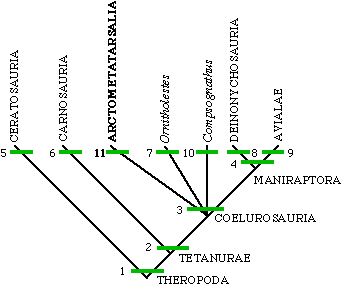 |
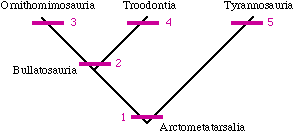 |
1. proximal half of metatarsal of digit III pinched
2. enlarged brain and eyes and reduced teeth
3. metacarpals of nearly equal length
4. teeth with large denticles
5. highly reduced forelimbs and large size
|
Therizinosauria
Erlikosaurus - Mongolia
Segnosaurus - Mongolia
Alxasaurus - China
1. three-toed foot
2. digits IV and V lost on hand
3. long arms
4. semilunate carpal
5. fused pelvis
6. large hole in lacrimal bone in skull
7. ?no unique derived characters?
8. giant, hook-like claw on digit II of pes
9. flight feathers
10. ?no unique derived characters?
11. proximal half of metatarsal of digit III pinched
12. teeth lost in front of mouth and very large claws on manus
|
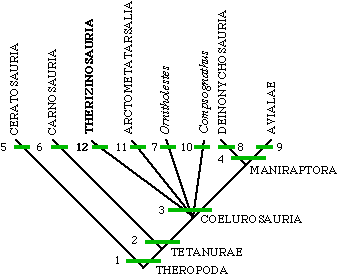 |
?
Compsognathus prima (Sinosauropteryx) - Liaoning Province
http://www.dinosauria.com/jdp/archie/protosino.html
http://www.dinosauria.com/jdp/jdp.htm#sino
http://www.dinosauria.com/jdp/archie/sinonews.htm
Protarchaeopteryx robusta - Liaoning Province
http://www.newscientist.co.uk/ns/970419/archaeop_nf.html
Ornithurae
Confuciusornis sanctus - Liaoning Province
Carinatae
Chaoyangia - Liaoning Province
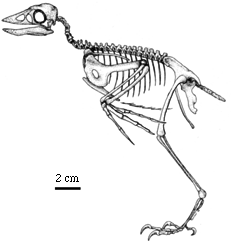
Confuciusornis sanctus, modified from Hou et al. (1996) |
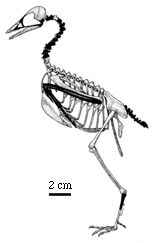
Chaoyangia, modified from Hou et al. (1996) |
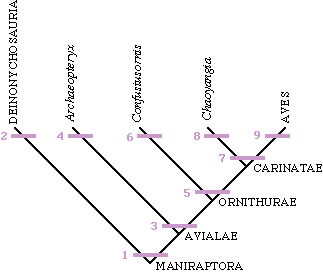 |
1. semilunate carpal
2. giant, hook-like claw on digit II of pes
3. flight feathers
4. no shared derived characters?
5. tail becomes pygostyle
6. elongated digit III or hand
7. enlarged keeled sternum
8. no shared derived characters?
9. loss of teeth
|
Marginocephalia
Yaverlandia Wealden
Psittacosaurus meileyinggensis - Liaoning Province
REFERENCES
Brett-Surman, M. K., 1997, Ornithopods. in Farlow, J. O. and Brett-Surman, M.K. (eds.) The Complete Dinosaur. pp.330-346.
Carpenter, K., 1997, Ankylosaurs. in Farlow, J. O. and Brett-Surman, M.K. (eds.) The Complete Dinosaur. pp.307-316.
Galton, P. M., 1974, The ornithischian dinosaur Hypsilophodon from the Wealden of the Isle of Wight. Bulletin of the British Museum (Natural History), Geology, vol. 25, p. 1-152.
Hou L., Martin, L. D., Zhou Z., Feduccia, A., 1996, Early adaptive radiation of birds; evidence from fossils from northeastern China. Science, v. 274n. 5290, p. 1164-1167
Ji, Q. and Ji, S., 1996. On discovery of the earliest bird fossil in China and the origin of birds. Chinese Geology 10 (233): 30-33.
Sereno, P. C., Rao C., 1992, Early evolution of avian flight and perching; new evidence from the Lower Cretaceous of China. Science, v. 255, n. 5046, p. 845-848.
Go to Lecture 21
BACK TO SYLLABUS
BACK TO THE DINOSAUR AND THE HISTORY OF LIFE HOME PAGE














